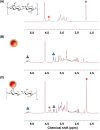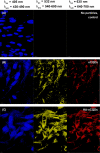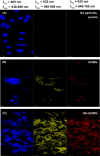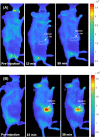Hyaluronan-Conjugated Carbon Quantum Dots for Bioimaging Use
- PMID: 33355448
- PMCID: PMC8243741
- DOI: 10.1021/acsami.0c20088
Hyaluronan-Conjugated Carbon Quantum Dots for Bioimaging Use
Abstract
This work demonstrates the application of hyaluronan-conjugated nitrogen-doped carbon quantum dots (HA-nCQDs) for bioimaging of tumor cells and illustrates their potential use as carriers in targeted drug delivery. Quantum dots are challenging to deliver with specificity, which hinders their application. To facilitate targeted internalization by cancer cells, hyaluronic acid, a natural ligand of CD44 receptors, was covalently grafted on nCQDs. The HA-nCQD conjugate was synthesized by carbodiimide coupling of the amine moieties on nCQDs and the carboxylic acids on HA chains. Conjugated HA-nCQD retained sufficient fluorescence, although with 30% lower quantum efficiency than the original nCQDs. Confocal microscopy showed enhanced internalization of HA-nCQDs, facilitated by CD44 receptors. To demonstrate the specificity of HA-nCQDs toward human tumor cells, patient-derived breast cancer tissue with high-CD44 expression was implanted in adult mice. The tumors were allowed to grow up to 200-250 mm3 prior to the injection of HA-nCQDs. With either local or systemic injection, we achieved a high level of tumor specificity judged by a strong signal-to-noise ratio between the tumor and the surrounding tissue in vivo. Overall, the results show that HA-nCQDs can be used for imaging of CD44-specific tumors in preclinical models of human cancer and potentially used as carriers for targeted drug delivery into CD44-rich cells.
Keywords: CD44 receptors; bioimaging; breast cancer; cancer; carbon quantum dots; hyaluronic acid; tumor imaging.
Conflict of interest statement
The authors declare no competing financial interest.
Figures










Similar articles
-
Dual-ligand functionalized carbon nanodots as green fluorescent nanosensors for cellular dual receptor-mediated targeted imaging.Analyst. 2019 Nov 4;144(22):6729-6735. doi: 10.1039/c9an01530b. Analyst. 2019. PMID: 31612877
-
Bioimaging of hyaluronic acid derivatives using nanosized carbon dots.Biomacromolecules. 2012 Aug 13;13(8):2554-61. doi: 10.1021/bm300796q. Epub 2012 Jul 30. Biomacromolecules. 2012. PMID: 22804331
-
Facile strategy by hyaluronic acid functional carbon dot-doxorubicin nanoparticles for CD44 targeted drug delivery and enhanced breast cancer therapy.Int J Pharm. 2020 Mar 30;578:119122. doi: 10.1016/j.ijpharm.2020.119122. Epub 2020 Feb 5. Int J Pharm. 2020. PMID: 32035259
-
High-quality quantum dots for multiplexed bioimaging: A critical review.Adv Colloid Interface Sci. 2020 Apr;278:102137. doi: 10.1016/j.cis.2020.102137. Epub 2020 Mar 5. Adv Colloid Interface Sci. 2020. PMID: 32171116 Review.
-
Roles and targeting of the HAS/hyaluronan/CD44 molecular system in cancer.Matrix Biol. 2017 May;59:3-22. doi: 10.1016/j.matbio.2016.10.001. Epub 2016 Oct 13. Matrix Biol. 2017. PMID: 27746219 Review.
Cited by
-
CD44 Receptor-Mediated Ferroptosis Induction by Hyaluronic Acid Carbon Quantum Dots in Triple-Negative Breast Cancer Cells Through Downregulation of SLC7A11 Pathway.Materials (Basel). 2025 May 6;18(9):2139. doi: 10.3390/ma18092139. Materials (Basel). 2025. PMID: 40363642 Free PMC article.
-
A Novel Ratiometric Fluorescent Probe Based on Carbon Dots and Rhodamine for Rapid Detection of Hg2+ in Herbal Medicines and Rivers.J Fluoresc. 2025 May 27. doi: 10.1007/s10895-025-04367-y. Online ahead of print. J Fluoresc. 2025. PMID: 40423928
-
Protein Corona Hinders N-CQDs Oxidative Potential and Favors Their Application as Nanobiocatalytic System.Int J Mol Sci. 2021 Jul 29;22(15):8136. doi: 10.3390/ijms22158136. Int J Mol Sci. 2021. PMID: 34360901 Free PMC article.
-
A Green Synthesis Route to Derive Carbon Quantum Dots for Bioimaging Cancer Cells.Nanomaterials (Basel). 2023 Jul 19;13(14):2103. doi: 10.3390/nano13142103. Nanomaterials (Basel). 2023. PMID: 37513114 Free PMC article.
-
Multistage Nanocarrier Based on an Oil Core-Graphene Oxide Shell.Pharmaceutics. 2024 Jun 18;16(6):827. doi: 10.3390/pharmaceutics16060827. Pharmaceutics. 2024. PMID: 38931947 Free PMC article.
References
-
- Hola K.; Zhang Y.; Wang Y.; Giannelis E. P.; Zboril R.; Rogach A. L. Carbon dots-Emerging light emitters for bioimaging, cancer therapy and optoelectronics. Nano Today 2014, 9, 590–603. 10.1016/j.nantod.2014.09.004. - DOI
MeSH terms
Substances
Grants and funding
LinkOut - more resources
Full Text Sources
Medical
Miscellaneous

